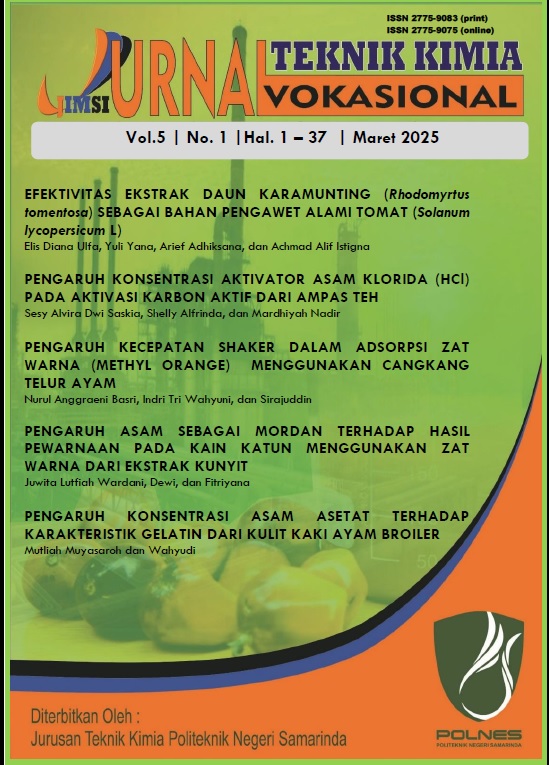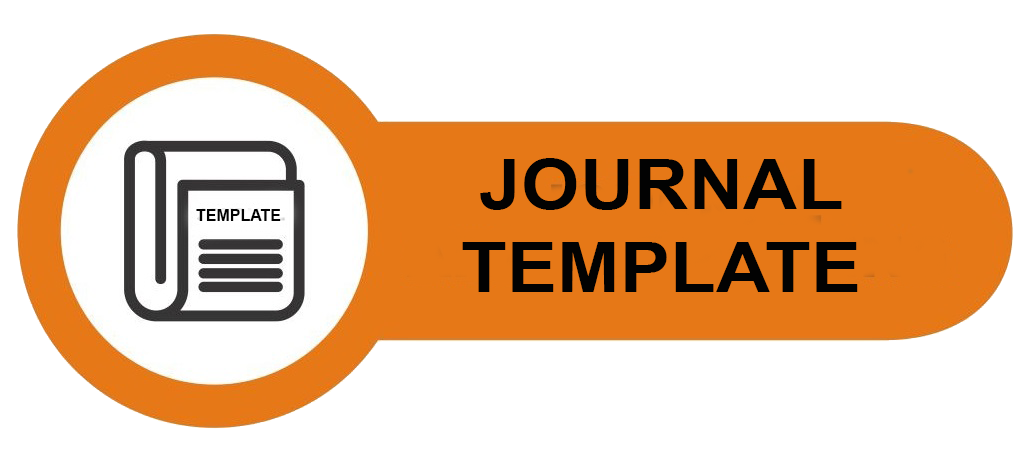EFEKTIVITAS EKSTRAK DAUN KARAMUNTING (Rhodomyrtus tomentosa) SEBAGAI BAHAN PENGAWET ALAMI TOMAT (Solanum lycopersicum L)
 Abstract views: 34
,
Abstract views: 34
,
 pdf downloads: 49
pdf downloads: 49
Abstract
Tomatoes are classified as a horticultural commodity that is very perishable which can cause shrinkage in quantity and quality. After harvesting tomatoes, there is still a metabolic process so that there is the potential for damage. Efforts are needed to maintain the quality of tomatoes by preserving them using natural preservatives from natural ingredients such as karamunting leaf extract. Positive karamunting leaves contain alkaloid compounds, flavonoids, saponins, tannins, triterpenoids, steroids and carbohydrates with potential antioxidant and antimicrobial compounds. This study aims to determine the effectiveness of karamunting leaf extract as a natural preservative of tomatoes. The tomato preservation process begins by washing them thoroughly and draining them. Then the tomatoes are dipped in a solution of karamunting leaf extract with concentration variations of 0%, 2%, 4%, 6%, and 8% in 100 mL of solution for 5 seconds and left for several days at room temperature until optimal storage. The results of the study showed that karamunting leaf extract as a natural preservative was effective for preserving tomatoes. The best tomato preservation was obtained in the use of 8% karamunting leaf extract with tomato durability for 19 days, weight loss of 3.74%, and vitamin C content of 29.883 mg.
Copyright (c) 2025 JURNAL TEKNIK KIMIA VOKASIONAL (JIMSI)

This work is licensed under a Creative Commons Attribution-NonCommercial-ShareAlike 4.0 International License.
Copyright Transfer Statement
The copyright of this article is transferred to JIMSI and when the article is accepted for publication. the authors transfer all and all rights into and to paper including but not limited to all copyrights in the Psikostudia. The author represents and warrants that the original is the original and that he/she is the author of this paper unless the material is clearly identified as the original source, with notification of the permission of the copyright owner if necessary. The author states that he has the authority and authority to make and carry out this task.
The author states that:
- This paper has not been published in the same form elsewhere.
- This will not be submitted elsewhere for publication prior to acceptance/rejection by this Journal.
A Copyright permission is obtained for material published elsewhere and who require permission for this reproduction. Furthermore, I / We hereby transfer the unlimited publication rights of the above paper to Jurnal Teknik Kimia Vokasional. Copyright transfer includes exclusive rights to reproduce and distribute articles, including reprints, translations, photographic reproductions, microforms, electronic forms (offline, online), or other similar reproductions.
The author's mark is appropriate for and accepts responsibility for releasing this material on behalf of any and all coauthor. This Agreement shall be signed by at least one author who has obtained the consent of the co-author (s) if applicable. After the submission of this agreement is signed by the author concerned, the amendment of the author or in the order of the author listed shall not be accepted.
Rights / Terms and Conditions Saved
- The author keeps all proprietary rights in every process, procedure, or article creation described in Work.
- The author may reproduce or permit others to reproduce the work or derivative works for the author's personal use or for the use of the company, provided that the source and the Informatika Mulawarman copyright notice are indicated, the copy is not used in any way implying the Jurnal Psikostudia approval of the product or service from any company, and the copy itself is not offered for sale.
- Although authors are permitted to reuse all or part of the Works in other works, this does not include granting third-party requests to reprint, republish, or other types of reuse.
Jurnal Teknik Kimia Vokasional by http://e-journal.polnes.ac.id/index.php/jimsi licensed under a Creative Commons Attribution-ShareAlike 4.0 International License.








